A Day in Skagway
To continue on my trip to Alaska, our second docking was in Skagway. We got an entire day here, which was just as well, because it was raining when we arrived. Hubby and I braved the elements and walked around the town, which consisted of a few blocks of buildings, all historical, all which had been moved there by the town for the tourists to see.
Skagway is home to the infamous Soapy Smith, the conman who preyed on local Klondikers who were searching for the dream of gold, but became somewhat of a hero, since he financed a bunch of things for the town. He was killed in a gunfight with Ken Reid. For more on this historical figure, click here.
Skagway has the feel of an old-time western, with buildings like the Red Onion Saloon (a famous brothel) and the Skagway Bazaar, complete with boardwalks lining the road.
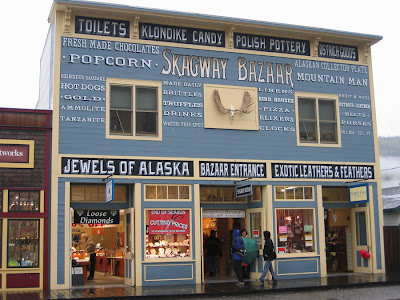
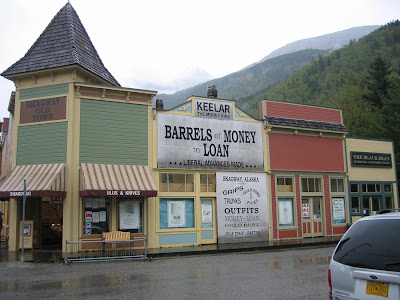
One of these old buildings housed a great little yarn and needlecraft shop called Changing Threads. I found this one while peering down the streets looking for the local library for hubby to do some work.
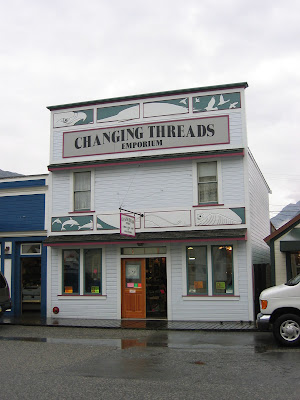
The people who worked here were as delightful as anything - just the type of people I like to meet at a yarn shop. It was here that I got my first glimpse of the famous Qivuit yarn, made from the fluff of the musk ox. It was sitting behind glass, and had the rather luxurious cost of $92 a ball!

Needless to say, it did not join my stash. It was interesting to see, though. I was too afraid of wrecking it to ask to handle it!
I did, however, acquire a Nostepinne, a Scandinavian ball-winder. It's made a maple, with a handle made of a type of wood called purple heart. Purple heart is a kind of tree that, when cut, the wood quickly turns from dark brown to deep purple. I've already given it a whirl with the Rabbit Ridge yarn I bought in Juneau, and it works great! I also bought a bone crochet hook - just something I liked the look of and wanted to try. I haven't tried it out yet, but it's a good weight, and it makes me think that I've got a link to the first crocheters... perhaps they used similar hooks - who knows?

Skagway's great claim to fame is that it was one of the last "civilized" stops on the way up to the great promised-land of Klondike gold. Unfortunately, by the time most of the men got there, traveled all the way to this "sure thing," the gold was all gone. They did, however, decide to change their fortunes by building a railway, to transport goods up and down the valley to settlements that had formed there. This was called the White Pass Railway, and we managed to get seats on a tour that would take us to the White Pass summit.
We passed amazing sights on the way. Here is the railroad, just teetering on the edge of a narrow ledge of rock:
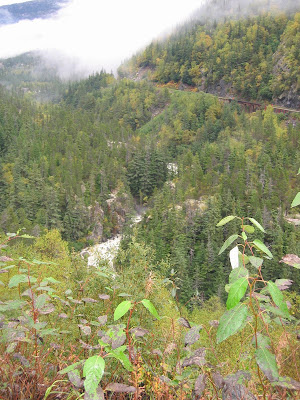
Here is a waterfall that has a pipe running next to it. The water in that pipe runs to a hydro-electric generator, that generates enough electricity to sell all over Alaska and beyond:
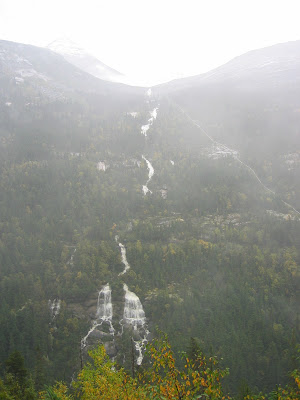
Check this bridge - you can barely see it in the landscape:
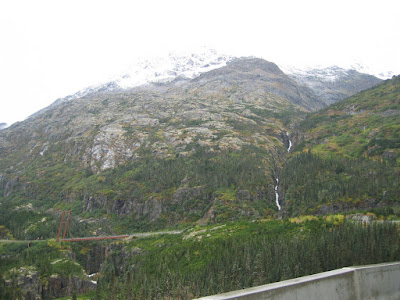
And when we reached the summit, I felt like I was on another planet. You can clearly see three different lands: the scrub, the treeline, and the rocky mountaintops. And, it was the site of the "International Bathrooms" (i.e. outhouses). I won't repeat the joke (I feel guilty for taking it from the tourguide), but it's a good one when you hear it!


Afterwards, we headed to the Gold Rush Cemetery. There is a newer cemetery in Skagway, but the funny thing is, no one dies in Skagway these days. Reason? There's no hospital. When you get sick, you get sent to the hospital in Juneau. But certainly, people died back during the days of the Gold Rush.

It looks like a movie set, doesn't it? Those trees grew up around that cemetery. One hundred years ago, it had been cleared. It is now maintained by the historical society, who replace the wooden headstones to retain the epitaphs of these people that often read, "Unknown." It is a strange, dark, sad place. So many people, with so many hope... men, women, and children, coming to an unknown place for an unknown future. And here they rest. I wonder if their families ever knew where they ended up?
And yet, I admire their sense of adventure, and of hope. How brave did you have to be to travel so long, without any promise of return? The departure would be like losing a loved one to death - certainly no guarantee of getting them back. But they went - and they made history.
What a fascinating place.
Skagway is home to the infamous Soapy Smith, the conman who preyed on local Klondikers who were searching for the dream of gold, but became somewhat of a hero, since he financed a bunch of things for the town. He was killed in a gunfight with Ken Reid. For more on this historical figure, click here.
Skagway has the feel of an old-time western, with buildings like the Red Onion Saloon (a famous brothel) and the Skagway Bazaar, complete with boardwalks lining the road.
One of these old buildings housed a great little yarn and needlecraft shop called Changing Threads. I found this one while peering down the streets looking for the local library for hubby to do some work.
The people who worked here were as delightful as anything - just the type of people I like to meet at a yarn shop. It was here that I got my first glimpse of the famous Qivuit yarn, made from the fluff of the musk ox. It was sitting behind glass, and had the rather luxurious cost of $92 a ball!
Needless to say, it did not join my stash. It was interesting to see, though. I was too afraid of wrecking it to ask to handle it!
I did, however, acquire a Nostepinne, a Scandinavian ball-winder. It's made a maple, with a handle made of a type of wood called purple heart. Purple heart is a kind of tree that, when cut, the wood quickly turns from dark brown to deep purple. I've already given it a whirl with the Rabbit Ridge yarn I bought in Juneau, and it works great! I also bought a bone crochet hook - just something I liked the look of and wanted to try. I haven't tried it out yet, but it's a good weight, and it makes me think that I've got a link to the first crocheters... perhaps they used similar hooks - who knows?
Skagway's great claim to fame is that it was one of the last "civilized" stops on the way up to the great promised-land of Klondike gold. Unfortunately, by the time most of the men got there, traveled all the way to this "sure thing," the gold was all gone. They did, however, decide to change their fortunes by building a railway, to transport goods up and down the valley to settlements that had formed there. This was called the White Pass Railway, and we managed to get seats on a tour that would take us to the White Pass summit.
We passed amazing sights on the way. Here is the railroad, just teetering on the edge of a narrow ledge of rock:
Here is a waterfall that has a pipe running next to it. The water in that pipe runs to a hydro-electric generator, that generates enough electricity to sell all over Alaska and beyond:
Check this bridge - you can barely see it in the landscape:
And when we reached the summit, I felt like I was on another planet. You can clearly see three different lands: the scrub, the treeline, and the rocky mountaintops. And, it was the site of the "International Bathrooms" (i.e. outhouses). I won't repeat the joke (I feel guilty for taking it from the tourguide), but it's a good one when you hear it!
Afterwards, we headed to the Gold Rush Cemetery. There is a newer cemetery in Skagway, but the funny thing is, no one dies in Skagway these days. Reason? There's no hospital. When you get sick, you get sent to the hospital in Juneau. But certainly, people died back during the days of the Gold Rush.
It looks like a movie set, doesn't it? Those trees grew up around that cemetery. One hundred years ago, it had been cleared. It is now maintained by the historical society, who replace the wooden headstones to retain the epitaphs of these people that often read, "Unknown." It is a strange, dark, sad place. So many people, with so many hope... men, women, and children, coming to an unknown place for an unknown future. And here they rest. I wonder if their families ever knew where they ended up?
And yet, I admire their sense of adventure, and of hope. How brave did you have to be to travel so long, without any promise of return? The departure would be like losing a loved one to death - certainly no guarantee of getting them back. But they went - and they made history.
What a fascinating place.
Comments